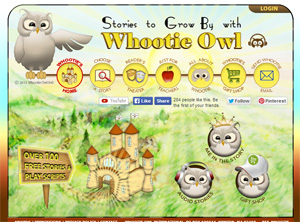 The Common Core State Standards for English Language Arts note robust expectations with regard to students’ reading skills. While CCSS do not specifically suggest technology can play a role in helping students develop these skills, the increased access to computers and handheld devices in schools provides teachers with opportunities to tap into the array of digital resources focused on reading. Various free and inexpensive websites and apps can be used strategically to augment print resources, including with primary-aged learners. Sites designed for young learners require minimal technology skills beyond clicking a mouse.
The Common Core State Standards for English Language Arts note robust expectations with regard to students’ reading skills. While CCSS do not specifically suggest technology can play a role in helping students develop these skills, the increased access to computers and handheld devices in schools provides teachers with opportunities to tap into the array of digital resources focused on reading. Various free and inexpensive websites and apps can be used strategically to augment print resources, including with primary-aged learners. Sites designed for young learners require minimal technology skills beyond clicking a mouse.
Narrated Digital Text Sites
Students can access on hardware both at school and at home websites featuring digital text provide teachers with instructional resources at multiple reading levels. Several resources highlight text as words are narrated by a reader, a useful strategy for helping emerging readers. Narration allows students to access text at higher levels than they are able to read independently. Listed resources provide students with good models of fluent readers, especially since students can listen to the tone, pitch, and expression of the reader. The capacity to start, stop, and repeat passages provides differential support as needed for individual students, as do the visual cues provided at several of the sites.
- Storyline Online: Actors and actresses read a variety of stories. Click close captioning (CC) to display words as stories are read. Questions about story content are available.
- Reading is Fundamental: Informational stories and some fairy tales are included.
- Between the Lions: Fables and folktales with audio and illustrations are available by clicking “Stories.” Be sure closed captioning (CC) is on. The site includes other early-reading activities.
- Children’s Storybooks Online: Some books only have text with illustrations while others include audio narration. Click the link to books for young children. The site also includes links to phonics activities.
- Mama Lisa’s World: Children’s songs and poems, some with audio and video, are available. Many of the Mother Goose rhymes include narration.
- Clifford Interactive Storybook: Narrated interactive stories allow students to choose words to complete displayed sentences. The site also includes phonics-based activity options.
In addition to the sites above, Storia is an e-reader that includes five free books with a complimentary Scholastic account. Additional books can be downloaded, costing between $1.99 and $7.99 each. Storia allows teachers to create a bookshelf for each child containing read-to-me and activities options based on the lexile level of each title. The PC version of Storia can be downloaded at the Scholastic website, and an iPad version can be downloaded at iTunes.
For informational texts, search for e-books at sites such as iTunes and Amazon by typing keywords related to content—such as “caterpillar.” Some books are free for download, while others are minimally priced. Many e-books include features such as font size adjustment, link to a dictionary, and note taking options. Students can stop and replay e-book content as needed, and they can access the text with visual and audio scaffolds that help them develop phonological awareness, phonics and word recognition, fluency, and comprehension. English learners may especially benefit from using eBooks.
Text-Only Sites
While narration and visual cues can help students read text, there are times when the lack of such features may contribute to reading skill development. For example, assessments aligned with the Common Core State Standards sometimes ask students to highlight evidence from the text. Available digitized text allows them to practice this task under teacher direction. After copying and pasting text from a site, students can be prompted to change words in sentences in ways that evoke a different meaning, an activity that requires them to carefully analyze the content. They could also be asked to highlight all of the words that rhyme with one named by the teacher, or even search for words as they ponder key ideas and details about the passage. Such tasks help to develop skills in using a word processor as well as build reading skills.
- Project Gutenburg: The children’s bookshelf contains a variety of content suited for beginning readers. Versions of stories suitable for web browsers and other e-readers are available. The reading level of content varies widely.
- Stories to Grow By with Whootie Owl: The stories are linked to various world cultures. The site includes text and some illustrations submitted by children.
- Fable Library: Simple illustrated stories and comics are available.
- Bedtime Stories: Some images accompany the text.
Apps
Apps, programs for handheld devices such as iPads or iPods, can be downloaded from iTunes and other sites. Even a limited number of hardware can be used effectively as part of rotations through learning centers or as timers prompt students to deliver the device to the next student on a list. Different apps can be loaded on each device, providing students with activities based on their specific needs and learning levels. Many apps focus on comprehension more than other reading skills, so they complement the resources noted above nicely. Several of the resources provide the learner with immediate feedback and several track student progress, providing teachers with useful assessment information. The table below notes titles available for download worth exploring at iTunes.

There are many useful literary and informational online resources that teachers can implement effectively to develop skilled readers. In fact, suggesting some of the resources to parents can extend learning opportunities outside of the classroom, providing students with rich practice opportunities at home. The sites offer students materials that are interesting and interactive, keeping students engaged in the learning process at levels consistent with their personal needs. With a little creativity, even teachers with limited classroom technology can engage their students using web resources and apps, contributing to broad reading skill development.
 Dawn Poole is a Professor of Educational Technology at California State University Stanislaus.
Dawn Poole is a Professor of Educational Technology at California State University Stanislaus.
 Whitney Donnelly is an Associate Professor of Teacher Education at California State University Stanislaus.
Whitney Donnelly is an Associate Professor of Teacher Education at California State University Stanislaus.